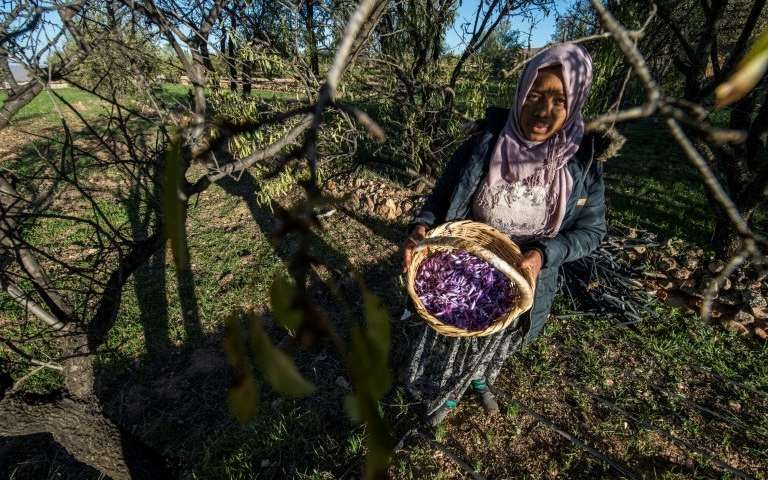Phys.org
by Ismail Bellaouali
Saffron farmers in southern Morocco are proud of the coveted spice they produce.
Saffron farmers in southern Morocco have long taken pride in the coveted spice they produce from the purple-petalled Crocus sativus, but some are worried knockoff versions are threatening their business.
“The pure saffron of Taliouine is the best in the world, according to experts,” local grower Barhim Afezzaa boasted, proudly noting his spice’s designation of origin (PDO) label.
But the 51-year-old is worried that “counterfeit” crops are tarnishing Taliouine’s reputation and its PDO—which guarantees a product’s origin and uniqueness.
In small plots below the snowy peaks of Mount Toubkal, saffron cultivation in Taliouine has remained largely unchanged for centuries.
The flower requires drastic climate conditions—hot summers and cold, wet winters—and it can only be harvested during a month-long window from mid-October to mid-November.
Workers start at dawn each morning, meticulously picking the delicate flowers by hand and placing them in wicker baskets. The purple blooms are picked before they fully open to ensure quality.
Once dried and sorted, the flower’s crimson stigmas and styles are turned into saffron—the world’s most expensive spice—popular with top chefs across the globe.
Morocco is the world’s fourth largest producer of saffron, behind Iran, India and Greece, according to the figures published in 2013 by FranceAgriMer, France’s specialist institute of agriculture and fishing.
Some of Morocco’s saffron farmers are worried about knockoff versions of the spice impacting on their business
‘From father to son’
The spice is both a source of pride and a lifeline in the Berber city of Taliouine, which, along with a neighbouring town, produces 90 percent of the kingdom’s saffron.
Some 1,500 families in Taliouine depend on sales from the crop to survive.
Knockoff versions “damage the image of this culture handed down from father to son, which is our pride”, said 24-year-old Driss, a member of a local collective in the area.
Morocco is the world’s fourth largest producer of saffron, behind Iran, India and Greece, according to FranceAgriMer, France’s specialist institute of agriculture and fishing Saffron’s rarity and its painstaking cultivation help explain its price—it takes nearly a kilogram (2.2 pounds) of flowers to create 12 grams of the spice.
In Morocco, PDO-certified saffron sells for about three euros ($3.5) a gram, according to Dar Azaafaran, or The House of Saffron, which works with 25 local cooperatives.
To maintain their PDO-label and association with Dar Azaafaran, producers submit their harvest for various tests that check for moisture content, taste, colour and smell.
Counterfeit saffron can sell “for less than a euro a gram at the famous Derb Omar market in Casablanca”, said Dar Azaafaran’s head Ismail Boukhriss.
The purple-petalled Crocus sativus, from which saffron is produced, requires hot summers and cold, wet winters and can only be harvested during a month-long window from mid-October.
Local producers say counterfeiters often use chemical dyes and remains of other plants in an attempt to pass poor quality saffron off as a top-shelf spice.
Boukhriss said that while authorities hold PDO-labelled producers to a high standard, “the informal market is not subjected to the same controls”.
The National Food Safety office told AFP that some “non-conformities” were detected in bulk sales of saffron which had not been properly packaged or labelled.
Once dried and sorted, the flower’s crimson stigmas and styles are turned into saffron—the world’s most expensive spice.
It advised buyers to only purchase “products labelled and packaged by approved and authorised sellers”.
Some say salesmen working to sell saffron outside the PDO-approved collective networks are to blame, while other small growers sell to middlemen to avoid payment delays common to larger groups.
Saffron farmers in southern Morocco are proud of their protected designation of origin label, guaranteeing a product’s origin and uniqueness
© 2018 AFP













